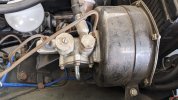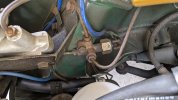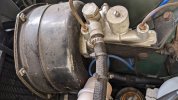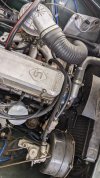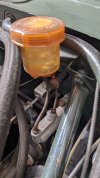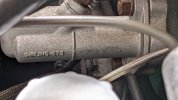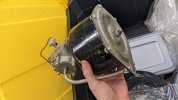Whiskey Whistle
Silver Level Sponsor
Hello,
I have my suspicion on what needs replacing, but would like y'all's input before I spend more time and money barking up the wrong tree.
While pressing the brakes, resistance against the leg's press is smooth until it hits a wall about 1-2" into the press. Pressing past the wall of increased resistance results in a sudden and powerful brake actuation, visibly pitching the car forward as it slows - and pulling a bit to the right. If the leg continues the press, braking continues to increase. If the leg lifts off and the pedal returns to its original position, then the leg returns to the pedal to press, it immediately meets the wall of resistance again.
I've pressure bled a whole gallon of brake fluid through, trying to force anything out causing a flapper valve. Didn't fix it. I found a small leak in a drum break piston and replaced it, but this didn't fix it either. Then I noticed that this wall of resistance isn't felt when the engine isn't running. Of course, the servo, the vacuum brake booster, I thought. I don't understand enough to realize exactly how it would cause this symptom, but it's my best lead at the moment.
So before I go buying a replacement, is there anything else I should check, or any easy fixes I should try first?
Thanks,
Whiskey
I have my suspicion on what needs replacing, but would like y'all's input before I spend more time and money barking up the wrong tree.
While pressing the brakes, resistance against the leg's press is smooth until it hits a wall about 1-2" into the press. Pressing past the wall of increased resistance results in a sudden and powerful brake actuation, visibly pitching the car forward as it slows - and pulling a bit to the right. If the leg continues the press, braking continues to increase. If the leg lifts off and the pedal returns to its original position, then the leg returns to the pedal to press, it immediately meets the wall of resistance again.
I've pressure bled a whole gallon of brake fluid through, trying to force anything out causing a flapper valve. Didn't fix it. I found a small leak in a drum break piston and replaced it, but this didn't fix it either. Then I noticed that this wall of resistance isn't felt when the engine isn't running. Of course, the servo, the vacuum brake booster, I thought. I don't understand enough to realize exactly how it would cause this symptom, but it's my best lead at the moment.
So before I go buying a replacement, is there anything else I should check, or any easy fixes I should try first?
Thanks,
Whiskey

